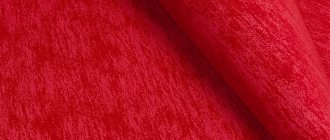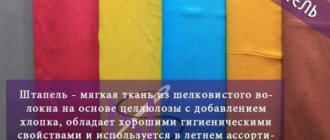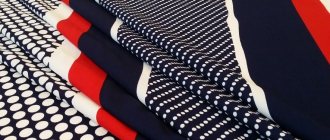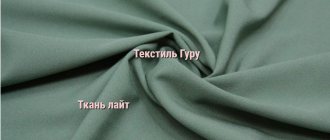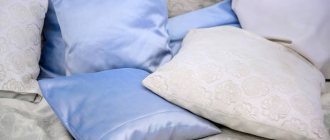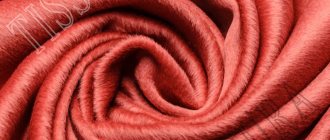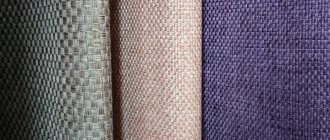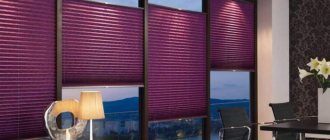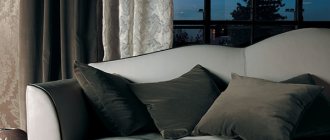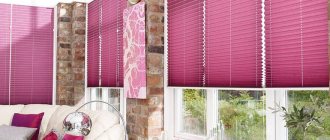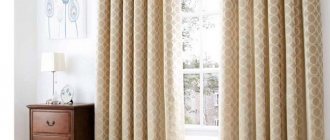Home / Products
Back
Published: 02/05/2021
Reading time: 2 min
3
112
Gabardine curtains are a whole category of fabrics. There is no connection to a specific matter. In this regard, there are models that differ in density, strength, structure and composition. Despite the visual and qualitative differences, this is one category of paintings.
- 1 Description of gabardine fabric for curtains
- 2 How to choose, examples of interior solutions with photos
- 3 Pros and cons of gabardine curtains
- 4 Care tips
- 5 Reviews
- 6 Conclusion
Description of gabardine fabric for curtains
Gabardine for curtains is produced in its pure form or combined with various types of fibers. Thus, the quality characteristics and appearance change.
| Fiber Types | Description |
| Natural | Cotton, wool, silk are used. |
| Mixed | Several types of natural threads are used (cotton with wool), or a mixture of natural and artificial fibers. |
| Synthetic | Polymer products have a characteristic shine. Products made from natural raw materials are matte. |
For information! Artificial impurities reduce the cost of production, so the price of gabardine fabric for curtains is lower than its analogues. In addition, the threads enhance the strength characteristics of the material.
Advantages of gabardine textiles for windows
Gabardine can be considered an ideal material in all respects for sewing curtains, as well as tablecloths and bedspreads, thanks to which you can create interesting ensembles.
- The complex twill weave makes the fabric dense and gives it water-repellent properties. Droplets of liquid falling on the surface of the canvas roll off faster than they can be absorbed. This property is reliable protection against stains, especially if there are children in the house who can spill something.
- The material allows air to pass through well, which is important in the summer, when at night the windows are open but tightly curtained.
- Wear resistance and durability are undeniable advantages. During the economic crisis, not everyone can afford to change curtains every season. Gabardine curtains completely solve this problem.
Important! Special impregnations protect the product from fading, the appearance of the curtains remains fresh, bright and presentable for a long time. This can be confirmed by those who have gabardine clothes in their wardrobe. A model goes out of fashion before the fabric wears out.
How to choose, examples of interior solutions with photos
The canvases are universal. Thanks to the variety of shapes, sizes and shades, they highlight the chosen interior.
If you study photos of finished design works, you will notice how stylish the canvases look in any space.
The right fabric will be the final element when creating the decor.
In order for the curtains to complement the chosen style, it is recommended to build on the following rules:
- density. Regardless of the number of threads per cm², curtains do not transmit sunlight well. Used as canvases combined with transparent curtains;
- color. If there are bright fragments in the room (furniture, decor), rich fabrics can “overload” the room. If there is a lack of saturated elements, contrasting material will create a visual accent;
- view. In addition to classic, straight models, there are Roman blinds, drapes, and with photo printing.
Note! The products do not belong to the expensive segment. The price depends on the composition (natural, synthetic).
Caring for gabardine curtains
Washing gabardine curtains does not require much effort, but following certain rules will help preserve the excellent properties of the fabric and the original appearance of the product.
- Before washing gabardine curtains, find out the exact composition of the material; the water temperature and the choice of product will depend on this.
- For woolen material, choose a delicate machine wash cycle at 30 degrees. It is better to take a special product for hair care. For cotton or synthetic curtains, a temperature of 40 degrees is acceptable for hand or machine washing.
- Rinse the product well to avoid soapy streaks on the dried curtain.
- You can wring out gabardine curtains.
- Do not iron with a hot iron, only through gauze, otherwise you risk damaging the product by burning and obtaining shine.
- Ventilate the room regularly, shake out curtains or vacuum each time you clean. This way, dust will not accumulate in large quantities from wash to wash.
Gabardine is an inexpensive and pliable material, so it can easily be used not only for curtains, but also for decorating a bed
Bright green curtains can become an indispensable accessory in the interior, attracting all the attention.
Despite the fact that gabardine curtains are a very budget-friendly window decoration, they look very presentable and stylish. So, away with stereotypes, let’s turn on our imagination and start experimenting. Good luck!
Pros and cons of gabardine curtains
The popularity of the paintings is due to the following qualities:
- light weight. Gabardine for curtains has a high density. Despite this criterion, massive canvases are quite light. No cornice reinforcement required;
- maintaining shape. After deformation, no folds remain. Does not stretch after numerous washes;
- wear resistance. Withstands loads, resistance to mechanical damage and rupture;
- allows air to pass through. Natural circulation is maintained when the curtains are tightly drawn;
- glossy or matte surface. Selected for a specific interior. The presence of shine depends on the components included in the composition.
Along with the advantages, matter has disadvantages:
- partial absorption of light. Regardless of the density of the canvas, they block light by 70%;
- complexity of cutting. When adjusting the length yourself, the edges fall off. It is necessary to leave a small fabric allowance.
For information! Gabardine curtains are invulnerable to UV radiation. Placement on the sunny side is acceptable. Prolonged exposure to direct light does not have a negative effect on brightness.
Constructing curtain patterns
To create a curtain pattern and calculate the required amount of material, you need to take measurements from the window. The following measurements need to be taken:
- height from the top edge of the cornice to the floor;
- window opening width;
- the width of the cornice from one fastening element to another.
If the width of the cornice is narrower than the window, then it is wiser to change this element, since in this case the curtains will not cover the partition and there will be an unsightly gap between them. Next, the width of the future canvas must be increased by 2.5 times. This way you create a supply of fabric for horizontal folds. It is not needed only if you are going to sew smooth Japanese curtains or curtains with horizontal folds (for example, French ones). Then your pattern will look like shown in Fig. 1.
Once you have decided on the overall width of the curtain, you need to take into account the allowances for hemming the fabric on the sides. Usually they are 1.5-5 cm. The thicker the fabric, the narrower the hem should be. Some novice craftswomen do not process the material, but leave a factory edge, positioning the canvas so that it is on the sides. But this technique does not add beauty to the curtains.
Next you need to calculate the length of the curtain. It should be equal to the height measurement from the floor to the edge of the cornice plus 10 cm. In addition, it is necessary to leave an allowance at the top (3-5 cm) and bottom (7-10 cm). Most likely, such a curtain will be too long. But this supply of fabric is necessary to adjust the size of the curtain. It is much easier to trim the fabric later than to build up the missing material. The calculation of a simple canvas and the preparation of a pattern is shown in Fig. 2.
Naturally, if your main curtain consists of 2 panels, then allowances are added separately to each panel, and the width of the window must first be divided by 2, and only then the resulting figure multiplied by 2.5 (additional material for forming folds).
Next, you need to create a drawing of a pattern for a lambrequin, tiebacks, ties and other decorative elements. The pattern for the simplest lambrequin with vertical ties is shown in Fig. 3.
You can make your own changes to the proposed measurements. But it is worth remembering that the lambrequin should not exceed 1/3 of the length of the entire curtain, and the ties should not be lower than 2/3. Otherwise, the composition of the curtain will be disrupted.
Care Tips
The material is not considered capricious. Thanks to the water-repellent coating, dirt does not penetrate deep into the threads.
However, when cleaning products, it is important to take into account the features of the composition:
- Models containing wool require dry cleaning. It is difficult to follow the cleaning technology on your own. Other types are machine washable;
- use liquid detergents. It is allowed to add mild stain removers without chlorine;
- There are no restrictions on the number of revolutions during spinning. The fabric is resistant to deformation;
- dry in a well-ventilated area. Pre-straighten;
- Ironing is optional. The curtains will return to their original shape under their own weight.
Author:
Anastasia Kukushkina
I hope you enjoy the article I have prepared for you! If you find errors in it, write to me about it! I will answer any questions you have, ask them!
